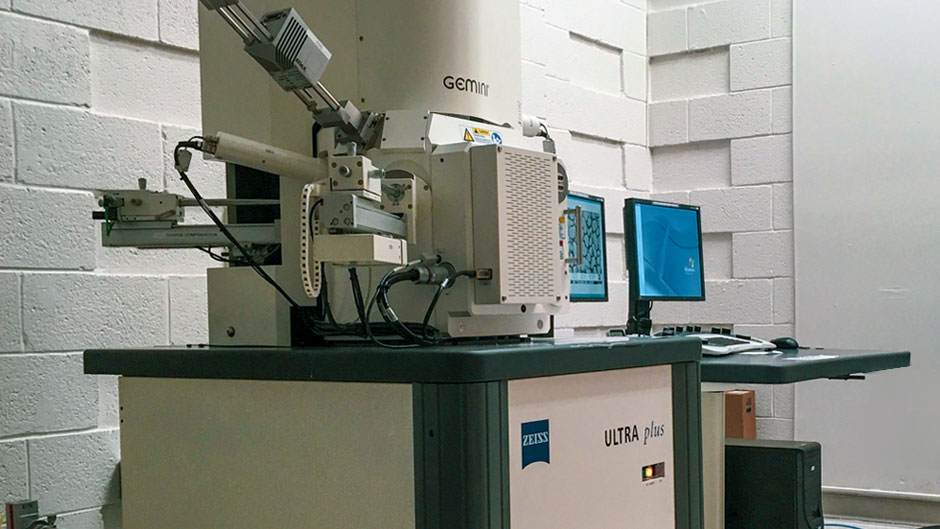During reentry into the Earth’s atmosphere, temperatures on the surface of NASA’s space shuttle would reach a searing 1,650 degrees Celsius. Yet, inside the orbiter, astronauts sat safe and sound, protected from the fiery descent by special tiles that also preserved the shuttle’s critical components.
Engineers spent months developing those tiles, subjecting them to a process called materials characterization, in which the mechanical and microstructural properties of substances such as metals and composites are tested and examined under extreme conditions.
University of Miami researchers James Coakley and Giacomo Po know the process better than anyone. And now, their research—which ranges from improving the performance of superalloys in gas turbine engines to investigating the ability of materials to withstand the harsh environment of a potential fusion reactor—stands to benefit immensely from a new scanning electron microscope (SEM) and testing tool at the College of Engineering that promises to accelerate the application of advanced materials in a multitude of industries.
Coakley and Po, assistant professors of mechanical and aerospace engineering, installed the SEM just before the Thanksgiving holiday, testing its sub-nanometer imaging capabilities shortly after.
They have paired the device with a new in-situ nanoindenter, an instrument that will allow the researchers to subject materials to extreme conditions within the SEM to study how the substances respond to such harsh conditions. Together, the nanoindenter and SEM are able to operate up to 1,000 degrees Celsius, mimicking some of the high-temperature environments materials will be subjected to in the real world.
“With in-situ SEM micromechanics, we’re able to observe what happens to the microstructure of materials under high temperatures and loads, and this helps in developing new ideas to optimize materials for use in extreme environments,” Po said.
It is a concept that is one of the key provisions of President Barack Obama’s Materials Genome Initiative, a multiagency endeavor designed to fast-track the discovery, manufacture, and use of advanced materials to address challenges in clean energy, national security, and human welfare.
As such, Coakley and Po will conduct extensive physical modeling of materials behavior. “Normally, structural materials are the limiting factor in high-temperature components and being able to predict their behavior is the key to enable new technologies,” Po explained. “With the advance of integrated computational materials engineering, the idea is that we can integrate materials optimization at each phase of the design flow. And we can only do that if we know exactly how materials are going to behave under specific types of loads.”
Coakley said the new microscope and accompanying nanoindenter fill a void at the College of Engineering that prevented researchers from delving deeply into the underlying science of materials characterization. “But that’s what these tools will help us do—link real-world observations with microscopic behavior and the critical science,” he said.
Coakley, an expert in a class of materials called nickel-based superalloys, which are the most advanced heat-resistant metals used in jet engines, is excited about the implications the devices hold for his research. In one project, he hopes to enhance the microstructures of superalloys. And in another ongoing initiative, he is employing 3D printing to create novel metal matrix composites of greater strength and stiffness for the aerospace industry.
He hopes to secure National Science Foundation funding for both projects.
Po also works with nickel-based superalloys, but in the area of advanced heat exchangers. In a U.S. Department of Energy-funded project, he is trying to design a lightweight heat exchanger capable of operating up to 800 degrees Celsius.
But it is another DOE-supported project that Po is most excited about. In that study, he is examining materials that can withstand the extraordinarily high temperatures that are produced by nuclear fusion reactors. In fusion, which powers the sun and the stars, lightweight atoms are brought together at temperatures of tens of millions of degrees to release energy. Mimicking the way the sun produces such energy offers the prospect of an inestimable source of energy on Earth, but duplicating the process is still years away.
“One of the challenges in building the type of machine that could harness that energy is the material,” Po explained. “Future fusion devices are probably going to be the harshest environments for any material that humankind will ever create. We’re looking at one of the strongest materials for that application—tungsten.”
“Establishing the SEM laboratory during the current pandemic was a challenge that could only be overcome by a college-wide team effort led by Interim Dean Daniel Berg; supported by Helena Solo-Gabriele, associate dean for research; and executed by our facilities team of Troy Thompson and Elie Merheb," Coakley said.
Coakley and Po see the new SEM and nanoindenter being applied in other research areas at the University, from biomedicine to civil engineering. “This is a major step,” Coakley said, “Truly a strong foundation that will expand materials characterization at the University of Miami.”

